Object astronomy
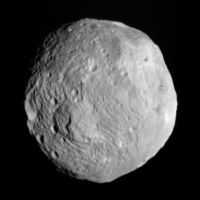
A natural object in any sky may be the subject of object astronomy.
Astronomy
Def. a natural object in the sky especially at night is called an astronomical object.
Planetary science

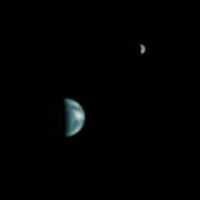
Objects
The SIMBAD reference database "contains identifications, 'basic data', bibliography, and selected observational measurements for several million astronomical objects."[1]
"The specificity of the SIMBAD database is to organize the information per astronomical object".[1] "Building a reference database for ... all astronomical objects outside the Solar System – has been the first goal of the CDS".[1] "The only astronomical objects specifically excluded from SIMBAD are the Sun and Solar System bodies."[1]
Def. a natural object in the sky especially at night is called an astronomical object.
A celestial object is any astronomical object except the Earth.
Some objects seem to wander around in the night sky relative to many of the visual points of light. At least one occasionally is present in the early morning before sunrise as the Morning Star and after sunset as the Evening Star, the planet Venus. These wanderers and related objects are subjects for observational astronomy and some are meteors.
Others only make an appearance after decades, sometimes spectacularly.
Neutrons
"[G]alactic (X-ray pulsars, binary systems - black hole candidates) and extragalactic (blasars) objects [emit] gamma-rays [in periodical processes] and high-energy neutral radiation (gamma-rays, neutrons) [is emitted from] solar flares."[2]
Positrons
"It is possible that the X-ray continuum is primary while the radio and optical emission are secondary for all BL Lac objects when the effect of relativistic beaming is considered. Pair production is a possible mechanism for producing X-ray emissions, while the optical and radio emission would be a consequence of this model (Zdziarski & Lightman 1985; Svensson 1986; Fabian et al. 1986). Barr & Mushotzky (1986) showed a significant correlation between the X-ray luminosity and timescale of X-ray variability for Seyfert galaxies and quasars and interpreted this as evidence that the emitting plasma is near the limit of being dominated by electron-positron pairs."[3]
Neutrinos
“[S]ince many neutrinos [are assumed to] come from stellar cores and supernovae, they are released at great temperature/energy. As neutrinos do not interact with matter electromagnetically, they are by definition dark matter.”[4]
Gamma rays
Over the entire celestial sphere, SIMBAD currently records 3253 gamma-ray objects. Some of these, like 4U 1705-44, are low-mass X-ray binaries (LMXBs). Some, like V779 Centauri, are high-mass X-ray binaries (HXMBs). Others are quasi-stellar objects (PKS 1326-697), supernova remnants (SNRs) like Messier 1 (M 1), and Seyfert galaxies like M 98. Some gamma-ray emitting objects have not been sufficiently resolved to determine what they are.
X-rays
Many astronomical objects when studied with visual astronomy may not appear to also be X-ray objects.
The SIMBAD database "contains identifications, 'basic data', bibliography, and selected observational measurements for several million astronomical objects."[1] Among these are some 209,612 astronomical X-ray objects. This information is found by going to the SIMBAD cite listed under 'External links', clicking on "Criteria query" and entering into the box "otype='X'", without the quotes, for an 'object count', and clicking on 'submit query'.
Ultraviolets
"A PG 1159 star, often also called a pre-degenerate,[5] is a star with a hydrogen-deficient atmosphere which is in transition between being the central star of a planetary nebula and being a hot white dwarf. These stars are hot, with surface temperatures between 75,000 K and 200,000 K,[6] and are characterized by atmospheres with little hydrogen and absorption lines for helium, carbon and oxygen. ... The PG 1159 stars are named after their prototype, PG 1159-035. This star, found in the Palomar-Green survey of ultraviolet-excess stellar objects,[7] was the first PG 1159 star discovered."[8]
Blues
The Edinburgh-Cape Blue Object Survey is an astronomical catalog included in the list of astronomical catalogues. These catalogs are lists or tabulations of astronomical objects. They are "grouped together because they share a common type, morphology, origin, means of detection, or method of discovery."[9]
Yellows
"An abundance analysis of the yellow symbiotic system AG Draconis reveals it to be a metal-poor K-giant ([Fe/H]=-1.3) which is enriched in the heavy s-process elements. ... the other yellow symbiotic stars are probably low-metallicity objects as well."[10]
Reds
"The nature of extremely red objects (EROs) remains an open question in understanding the faint galaxy population at z > 1."[11]
Submillimeters
"On the whole the emission strength is low in the submillimeter for astronomical objects."[12]
Plasma objects
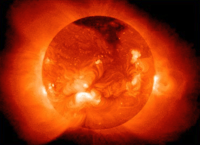
In physics and chemistry, plasma is a state of matter similar to gas in which a certain portion of the particles are ionized.
The image on the right shows the coronal clouds around and near to the Sun.
Gaseous objects
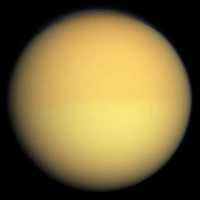
In orange astronomy, Titan is a gaseous object.
Titan like Venus is another gas dwarf when viewed in visible light. "Much as with Venus prior to the Space Age, the dense, opaque atmosphere prevented understanding of Titan's surface until new information accumulated with the arrival of the Cassini–Huygens mission in 2004, including the discovery of liquid hydrocarbon lakes in the ... polar regions."[13]
"The atmosphere of Titan is largely composed of nitrogen; minor components lead to the formation of methane and ethane clouds and nitrogen-rich organic smog."[13]
Titan has a mean radius of 2576 ± 2 km.[14]
Liquid objects

A division of astronomical objects between rocky objects, liquid objects, gaseous objects (including gas giants and stars), and plasma objects may be natural and informative.
The astronomy of liquid objects may be called liquid-object astronomy.
The image at right is a detailed, photo-like view of Earth based largely on observations from the Moderate Resolution Imaging Spectroradiometer (MODIS) on NASA’s Terra satellite.
Rocky objects
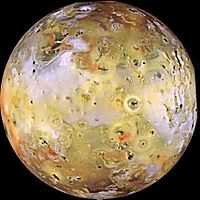
A division of astronomical objects between rocky objects, liquid objects, gaseous objects (including gas giants and stars), and plasma objects may be natural and informative.
This division allows moons like Io to be viewed as rocky objects like Earth, rather than as a satellite around Jupiter.
The astronomy of such objects may be called rocky-object astronomy.
Sun
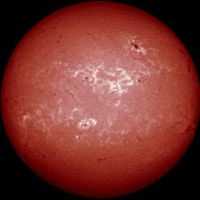
Depending primarily upon gas temperature, the presence of gas may be used to determine the composition of the gas object observed, at least the outer layer. Early spectroscopy[15] of the Sun using estimates of "the line intensities of several lines by eye [to derive] the abundances of ... elements ... [concluded] that the Sun [is] largely made of hydrogen."[16]
Venus
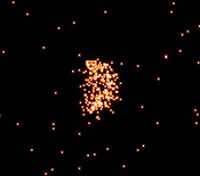
The right image is the first X-ray image ever made of Venus. It "shows a half crescent due to the relative orientation of the Sun, Earth and Venus. The X-rays from Venus are produced by fluorescent radiation from oxygen and other atoms in the atmosphere between 120 and 140 kilometers above the surface of the planet."[17] The fluorescent source of the X-rays places Venus in the gas dwarf category even though a rocky object lies some 120 km beneath this layer.
Comets
"The 1910 approach, which came into naked-eye view around 10 April[18] and came to perihelion on 20 April,[18] was notable for several reasons: it was the first approach of which photographs exist, and the first for which spectroscopic data were obtained.[19] Furthermore, the comet made a relatively close approach of 0.15AU,[18] making it a spectacular sight. Indeed, on 19 May, the Earth actually passed through the tail of the comet.[20][21] One of the substances discovered in the tail by spectroscopic analysis was the toxic gas cyanogen,[22] which led astronomer Camille Flammarion to claim that, when Earth passed through the tail, the gas "would impregnate the atmosphere and possibly snuff out all life on the planet."[10] His pronouncement led to panicked buying of gas masks and quack "anti-comet pills" and "anti-comet umbrellas" by the public.[23] In reality, as other astronomers were quick to point out, the gas is so diffuse that the world suffered no ill effects from the passage through the tail.[10]"[24]
"It is quite possible that [faint streamers preceding the main tail and lying nearly in the prolonged radius vector] may have touched the Earth, probably between May 19.0 and May 19.5, [1910,] but the Earth must have passed considerably to the south of the main portion of the tail [of Halley's comet]."[25]
Research
Hypothesis:
- Objects/Astronomy and Astronomy/Objects are the same things: astronomical objects.
Control groups

The findings demonstrate a statistically systematic change from the status quo or the control group.
“In the design of experiments, treatments [or special properties or characteristics] are applied to [or observed in] experimental units in the treatment group(s).[26] In comparative experiments, members of the complementary group, the control group, receive either no treatment or a standard treatment.[27]"[28]
Proof of concept
Def. a “short and/or incomplete realization of a certain method or idea to demonstrate its feasibility"[29] is called a proof of concept.
Def. evidence that demonstrates that a concept is possible is called proof of concept.
The proof-of-concept structure consists of
- background,
- procedures,
- findings, and
- interpretation.[30]
See also
References
- 1 2 3 4 5 Marc Wenger, François Ochsenbein, Daniel Egret, Pascal Dubois, François Bonnarel, Suzanne Borde, Françoise Genova, Gérard Jasniewicz, Suzanne Laloë, Soizick Lesteven, and Richard Monier (April 2000). "The SIMBAD astronomical database The CDS Reference Database for Astronomical Objects". Astronomy and Astrophysics 143 (4): 9-22. doi:10.1051/aas:2000332.
- ↑ Kudryavtsev M. I., Pankov V. M., Bogomolov A. V., Bogomolov V. V., Denisov Yu. I., Kolesov G. Ya., Logachev Yu. I., Svertilov S. I. (1995). N. Iucci and E. Lamanna. ed. The MIR-SPECTR Gamma-Astronomy Experiment. 3. Rome, Italy: International Union of Pure and Applied Physics. pp. 567-70. http://adsabs.harvard.edu/abs/1995ICRC....3..567K. Retrieved 2013-11-01.
- ↑ G. Z. Xie, B. F. Liu, and J. C. Wang (November 20, 1995). "A Signature of Relativistic Electron-Positron Beams in BL Lacertae Objects". The Astrophysical Journal 454 (11): 50-4. doi:10.1086/176463. http://adsabs.harvard.edu/full/1995ApJ...454...50X. Retrieved 2013-08-13.
- ↑ "Neutrino astronomy, In: Wikipedia". San Francisco, California: Wikimedia Foundation, Inc. March 5, 2012. Retrieved 2012-06-08.
- ↑ Jaschek & Jaschek: CARBON C
- ↑ Observational constraints on the evolutionary connection between PG 1159 stars and DO white dwarfs, S. D. Huegelmeyer, S. Dreizler, K. Werner, J. Krzesinski, A. Nitta, and S. J. Kleinman. arXiv:astro-ph/0610746.
- ↑ The Palomar-Green catalog of ultraviolet-excess stellar objects, R. F. Green, M. Schmidt, and J. Liebert, Astrophysical Journal Supplement 61 (June 1986), pp. 305–352. Centre de Données astronomiques de Strasbourg (CDS) ID II/207.
- ↑ "PG 1159 star, In: Wikipedia". San Francisco, California: Wikimedia Foundation, Inc. April 15, 2013. Retrieved 2013-07-02.
- ↑ "List of astronomical catalogues, In: Wikipedia". San Francisco, California: Wikimedia Foundation, Inc. May 19, 2013. Retrieved 2013-05-30.
- 1 2 3 V. V. Smith, K. Cunha, A. jorissen, H. M. J. Boffin (December 1996). "Abundances in the symbiotic star AG Draconis: the barium-symbiotic connection". Astronomy and Astrophysics 315 (11): 179-93. http://adsabs.harvard.edu/abs/1996A%26A...315..179S. Retrieved 2013-09-17.
- ↑ Michael C. Liu, Arjun Dey, James R. Graham, Charles C. Steidel and Kurt Adelberger (1999). Andrew J. Bunker and Wil J. M. van Breugel. ed. Extremely Red Galaxies in the Field of QSO 1213-0017: A Galaxy Concentration at z = 1.31, In: The Hy-Redshift Universe: Galaxy Formation and Evolution at High Redshift. 193. Berkeley, California USA: American Society of Physics. pp. 344-7. ISBN 1-58381-019-6. Bibcode: 1999ASPC..193..344L. http://adsabs.harvard.edu/full/1999ASPC..193..344L. Retrieved 2013-07-30.
- ↑ T.G. Phillips, J. Keene (November 1992). "Submillimeter astronomy [heterodyne spectroscopy"]. Proceedings of the IEEE 80 (11): 1662-78. doi:10.1109/5.175248. http://ieeexplore.ieee.org/xpls/abs_all.jsp?arnumber=175248. Retrieved 2013-10-21.
- 1 2 "Titan (moon), In: Wikipedia". San Francisco, California: Wikimedia Foundation, Inc. June 30, 2012. Retrieved 2012-07-01.
- ↑ R. A. Jacobson, P.G. Anreasian, J.J. Bordi, K.E. Criddle, R. Ionasescu, J.B. Jones, R. A. MacKenzie, M.C. Meek, D. Parcher (December 2006). "The Gravity Field of the Saturnian System from Satellite Observations and Spacecraft Tracking Data". The Astronomical Journal 132 (6): 2520-6. doi:10.1086/508812. http://iopscience.iop.org/1538-3881/132/6/2520/fulltext. Retrieved 2012-07-08.
- ↑ H. N. Russell (1929). The Astrophysical Journal 70: 11-82.
- ↑ Sarbani Basu and H. M. Antia (March 2008). "HelioseismologyandSolarAbundances". Physics Reports 457 (5-6): 217-83. doi:10.1016/j.physrep.2007.12.002.
- ↑ "File:Venus xray 420.jpg". Wikimedia Commons (San Francisco, California: Wikimedia Foundation, Inc). October 28, 2010. http://commons.wikimedia.org/wiki/File:Venus_xray_420.jpg. Retrieved 2012-08-08.
- 1 2 3 D. K. Yeomans (1998). "Great Comets in History". Jet Propulsion Laboratory. Retrieved 15 March 2007.
- ↑ D. A. Mendis (1988). "A Postencounter view of comets". Annual Review of Astronomy and Astrophysics 26 (1): 11–49. doi:10.1146/annurev.aa.26.090188.000303.
- ↑ Ian Ridpath (1985). "Through the comet’s tail". Revised extracts from A Comet Called Halley by Ian Ridpath, published by Cambridge University Press in 1985. Retrieved 2011-06-19.
- ↑ Brian Nunnally (May 16, 2011). "This Week in Science History: Halley’s Comet". pfizer: ThinkScience Now. Retrieved 2011-06-19.
- ↑ "Yerkes Observatory Finds Cyanogen in Spectrum of Halley's Comet". The New York Times. 8 February 1910. Retrieved 15 November 2009.
- ↑ "Interesting Facts About Comets". Universe Today. 2009. Retrieved 15 January 2009.
- ↑ "Halley's Comet, In: Wikipedia". San Francisco, California: Wikimedia Foundation, Inc. September 18, 2012. Retrieved 2012-09-19.
- ↑ Heber D. Curtis (June 1910). "Photographs of Halley's Comet made at the Lick Observatory". Publications of the Astronomical Society of the Pacific 22 (132): 117-30.
- ↑ Klaus Hinkelmann, Oscar Kempthorne (2008). Design and Analysis of Experiments, Volume I: Introduction to Experimental Design (2nd ed.). Wiley. ISBN 978-0-471-72756-9. http://books.google.com/?id=T3wWj2kVYZgC&printsec=frontcover.
- ↑ R. A. Bailey (2008). Design of comparative experiments. Cambridge University Press. ISBN 978-0-521-68357-9. http://www.cambridge.org/uk/catalogue/catalogue.asp?isbn=9780521683579.
- ↑ "Treatment and control groups, In: Wikipedia". San Francisco, California: Wikimedia Foundation, Inc. May 18, 2012. Retrieved 2012-05-31.
- ↑ "proof of concept, In: Wiktionary". San Francisco, California: Wikimedia Foundation, Inc. November 10, 2012. Retrieved 2013-01-13.
- ↑ Ginger Lehrman and Ian B Hogue, Sarah Palmer, Cheryl Jennings, Celsa A Spina, Ann Wiegand, Alan L Landay, Robert W Coombs, Douglas D Richman, John W Mellors, John M Coffin, Ronald J Bosch, David M Margolis (August 13, 2005). "Depletion of latent HIV-1 infection in vivo: a proof-of-concept study". Lancet 366 (9485): 549-55. doi:10.1016/S0140-6736(05)67098-5. http://www.ncbi.nlm.nih.gov/pmc/articles/PMC1894952/. Retrieved 2012-05-09.
External links
- African Journals Online
- Bing Advanced search
- Google Books
- Google scholar Advanced Scholar Search
- International Astronomical Union
- JSTOR
- Lycos search
- NASA/IPAC Extragalactic Database - NED
- NASA's National Space Science Data Center
- Office of Scientific & Technical Information
- Questia - The Online Library of Books and Journals
- SAGE journals online
- The SAO/NASA Astrophysics Data System
- Scirus for scientific information only advanced search
- SDSS Quick Look tool: SkyServer
- SIMBAD Astronomical Database
- SIMBAD Web interface, Harvard alternate
- Spacecraft Query at NASA.
- SpringerLink
- Taylor & Francis Online
- Universal coordinate converter
- Wiley Online Library Advanced Search
- Yahoo Advanced Web Search
![]() This is a research project at http://en.wikiversity.org
This is a research project at http://en.wikiversity.org
| |
Educational level: this is a research resource. |
| |
Resource type: this resource is an article. |
| |
Resource type: this resource contains a lecture or lecture notes. |
| |
Subject classification: this is an astronomy resource. |